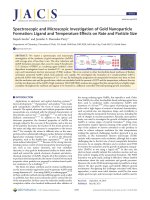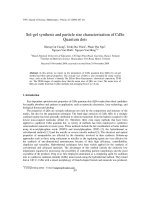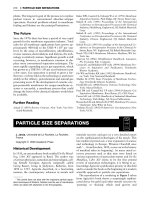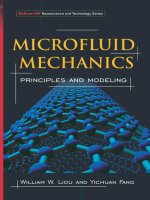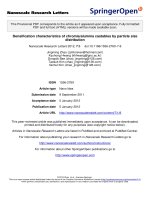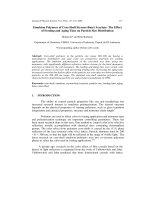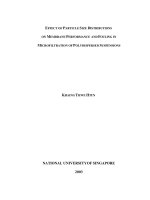(Particle technology series) terence allen particle size measurement volume 2 springer (1997)
Bạn đang xem bản rút gọn của tài liệu. Xem và tải ngay bản đầy đủ của tài liệu tại đây (4.85 MB, 256 trang )
Powder Technology Series
EDITED BY
BRIAN SCARLETT
and
Delft University of Technology
The Netherlands
GENJIJIMBO
Chubu Powtech Plaza Lab
Japan
Many materials exist in the form of a disperse system, for example powders, pastes,
slurries, emulsions and aerosols. The study of such systems necessarily arises in
many technologies but may alternatively be regarded as a separate subject which is
concerned with the manufacture, characterization and manipulation of such systems.
Chapman & Hall were one of the first publishers to recognize the basic importance
of the subject, going on to instigate this series of books. The series does not aspire
to define and confine the subject without duplication, but rather to provide a good
home for any book which has a contribution to make to the record of both the theory
and the application of the subject. We hope that all engineers and scientists who
concern themselves with disperse systems will use these books and that those who
become expert will contribute further to the series.
Chemistry of Powder Production
Yasuo Arai
Hardback (0 412 39540 1), 292 pages
Particle Size Analysis
Claus Bernhardt
Translated by H. Finken
Hardback (0 412 55880 7), 428 pages
Particle Classification
K. Heiskanen
Hardback (0 412 49300 4), 330 pages
Powder Surface Area and Porosity
S. Lowell and Joan E. Shields
3rd edn, hardback (0 412 39690 4), 256 pages
Pneumatic Conveying of Solids
R.D. Marcus, L.S. Leung, G.E. KJinzing and F. Rizk
Hardback (0 412 21490 3), 592 pages
Principles of Flow in Disperse Systems
O. Molerus
Hardback (0 412 40630 6), 314 pages
Particle Technology
Hans Rumpf
Translated by F.A. Bull
Hardback (0 412 35230 3), 216 pages
Processing of Particulate Solids
J.P.K. Seville, U. Tflzan and R. Clift
Hardback (0 751 40376 8), 384 pages
Particle Size
Measurement
Volume 2
Surface area and pore size determination
Fifth edition
TERENCE ALLEN
Formerly Senior Consultant
E.I. Dupont de Nemour and Company
Wilmington, Delaware, USA
E3
CHAPMAN & HALL
London • Weinheim • New York • Tokyo • Melbourne Madras
www.pdfgrip.com
Published by Chapman & Hall, 2-6 Boundary Row, London SKI 8HN, UK
Chapman & Hall, 2-6 Boundary Row, London SE1 8HN, UK
Chapman & Hall GmbH, Pappelallee 3, 69469 Weinheim, Germany
Chapman & Hall USA, 115 Fifth Avenue, New York. NY 10003, USA
Chapman & Hall Japan, ITPJapan. Kyowa Building, 3F, 2-2-1 Hirakawacho,
Chiyoda-ku, Tokyo 102, Japan
Chapman & Hall Australia, 102 Dodds Streel. South Melbourne, Victoria 3205,
Australia
Chapman & Hall India, R. Seshadri, 32 Second Main Road. CIT East, Madras 600 035,
India
First edition 1968
Second edition 1975
Third edition 1981
Fourth edition 1990
Fifth edition 1997
© 1 9 6 8 , 1975, 1981, 1990, 1997
T. Allen
Printed in Great Britain at T.J. Press (Padstow) Ltd., Padstow. Cornwall
ISBN 0 412 75330 8
0 412 75350 2 (2 volume set)
Apart from any fair dealing for the purposes of research or private study, or criticism or
review, as permitted under tht UK Copyright Designs and Patents Act, 1988, this
publication may not be reproduced, stored, or transmitted, in any form or by any means,
without the prior permission in writing of the publishers, or in the case of reprographic
reproduction only in accordance with the terms of the licences issued by the Copyright
Licensing Agency in the UK, or in accordance with the terms of licences issued by the
appropriate Reproduction Rights Organization outside the UK. Enquiries concerning
reproduction outside the terms stated here should be sent to the publishers at the
London address printed on this page.
The publisher makes no representation, express or implied, with regard to the accuracy
of the information contained in this book and cannot accept any legal responsibility or
liability for any errors or omissions that may be made.
A catalogue record for this book is available from the British Library
Library of Congress Catalog Card number: 96-86676
V ^ Printed on permanent acid-free tent paper, manufactured In accordance with
ANSI/NISO Z39.48-1992 and ANSI/NISO Z39.48-1984 (Permanence of Paper).
www.pdfgrip.com
Contents
Acknowledgments
xi
Preface to fifth edition
xiii
Preface to first edition
xv
Editor's foreword
1.
1.1
1.2
1.3
1.4
1.5
1.6
1.7
1.8
1.9
1.10
1.11
12
13
14
15
16
17
1.18
1.19
xvii
Permeametry and gas diffusion
Flow of a viscous fluid through a packed bed of powder
The aspect factor k
Other flow equations .
Experimental applications
Bed preparation
Constant flow rate permeameters
1.6.1
The Lea and Nurse permeameter
1.6.2
The Fisher sub-sieve sizer
Constant volume permeameters
1.7.1
The Blaine apparatus
1.7.2
The Griffin Surface Area of Powder Apparatus
1.7.3
Reynolds and Branson autopermeameter
1.7.4
Pechukas and Gage permeameter
Types of flow
Transitional region between viscous and molecular flow
Calculation of permeability surface
An experimental approach to the two-term permeametry
equation
Diffusional flow for surface area measurement
The relationship between diffusion constant
and specific surface
Non-steady state diffusional flow
Steady state diffusional flow
The liquid phase permeameter
Application to hindered settling
Turbo Powdersizer Model TPO-400 In-Line
Grain Analyzer
Permoporometry
1.19.1 Theory
www.pdfgrip.com
1
1
4
6
11
12
12
12
13
16
16
18
18
18
19
20
21
23
24
26
27
29
32
32
33
33
33
vi Contents
2
2.1
2.2
2.3
Surface area determination by gas adsorption
Introduction
Shapes of isotherms
Langmuir's equation for monolayer adsorption
2.3.1
Henry's law
2.3.2
Halsey equation
2.3.3
Freundlich equation
2.3.4
Sips equation
2.4
BET equation for multilayer adsorption
2.4.1
Single point BET method
2.4.2
Discussion of the BET equation
2.4.3
Mathematical nature of the BET equation
2.4.4
n-layer BET equation
2.4.5
Pickett's equation
2.4.6
Anderson's equation
2.5
Polanyi's theory for micropore adsorption
2.6
Dubinen-Radushkevich equation
2.6.1
Dubinen-Askakhov equation
2.6.2
Dubinen-Kaganer equation
2.7
Jovanovic equations
2.8
Hiittig equation
2.9
Harkins and Jura relative method
2.10 Comparison between BET and HJr methods
2.11 Frenkel-Halsey-Hill equation
2.12 V-t curve
2.13 Kiselev's equation
2.14 Experimental techniques
2.14.1 Introduction
2.15 Volumetric methods
2.15.1 Volumetric methods for high surface areas
2.15.2 Volumetric methods for low surface areas
2.16 Gravimetric methods
2.16.1 Single spring balances
2.16.2 Multiple spring balances
2.16.3 Beam balances
2.17 Flow, thermoconductivity methods
2.18. Sample preparation
2.18.1 Degassing
2.18.2 Pressure
2.18.3 Temperature and time
2.18.4 Adsorbate.
2.14.5 Interlaboratory tests
2.19 Standard volumetric gas adsorption apparatus
2.19.1 Worked example using BS 4359
standard apparatus
2.20 Haynes apparatus
2.21 Commercial equipment
www.pdfgrip.com
39
39
40
43
45
46
46
46
47
51
52
53
56
57
57
58
58
60
60
61
62
62
64
64
65
66
68
68
68
68
70
71
72
72
73
74
78
78
78
79
79
81
81
83
86
86
Contents vii
2.21.1
2.21.2
2.21.3
3
3.1
3.2
3.3
3.4
3.5
3.6
3.7
3.8
3.9
3.10
3.11
3.12
3.13
3.14
3.15
3.16
4
4
4.1
4.2
4.3
4.4
4.5
4.6
4.7
4.8
4.9
4.10
4.11
4.12
4.13
Static volumetric apparatus
Continuous flow gas chromatographic methods
Gravimetric methods
Determination of pore size distribution by gas
adsorption
Introduction
The Kelvin equation
The hysteresis loop
Theoretical evaluation of hysteresis loops
3.4.1
Cylindrical pore model
3.4.2
Ink-bottle pore model
3.4.3
Parallel plate model
Classification of pores
Relationship between the thickness of the adsorbed
layer and the relative pressure
Non-linear V-t curves
The as method
The ns-nR method
Relationship between gas volume and condensed
liquid volume for nitrogen
Pore size determination
3.11.1 ModeUess method
3.11.2 Cylindrical core model
3.11.3 Cylindrical pore model
3.11.4 Parallel plate model
Network theory
Analysis of micropores; the MP method
Density functional theory
Benzene desorption
Other adsorbates
Pore size determination by mercury porosimetry
Introduction
Relationship between pore radii and intrusion pressure
Equipment fundamentals
Incremental mode
Continuous mode
Discussion
Limitations of mercury porosimetry
Effect of interconnecting pores
Hysteresis
Contact angle for mercury
4.10.1 Effect of contact angle
Surface tension of mercury
Corrections for compressibility
Structural damage
www.pdfgrip.com
86
92
96
104
104
105
108
111
111
112
113
113
114
119
120
121
121
122
122
127
127
131
136
138
143
143
144
149
149
150
151
153
154
155
157
159
159
161
162
162
163
165
vm Contents
4.14
4.15
4.16
4.17
4.18
4.19
4.20
4.21
4.22
4.23
4.24
5
5.1
5.2
5.3
5.4
5.5
5.6
5.7
5.8
5.9
Delayed intrusion
Theory for volume distribution determination
Theory for surface distribution determination
4.16.1 Cylindrical pore model
4.16.2 Modelless method
Theory for length distribution determination
Illustrative examples
4.18.1 Narrow size range
4.18.2 Wide size range
Commercial equipment
4.19.1 Incremental mode
4.19.2 Incremental and continuous mode
4.19.3 Continuous mode
Anglometers
Assessment of mercury porosimetry
4.21.1 Effect of experimental errors
Mercury porosimetry report
4.22.1 Data
Liquid porosimetry
Applications
165
166
167
167
167
168
169
169
169
175
175
175
176
177
179
179
180
181
182
187
Other methods for determining surface area
Introduction
Determination of specific surface from size
distribution data
5.2.1
Number distribution
5.2.2
Surface distribution
5.2.3
Volume (mass) distribution
Turbidity methods of surface area determination
Adsorption from solution
5.4.1
Molecular orientation at the solid-liquid
interface
5.4.2
Polarity of organic liquids and adsorbents
5.4.3
Drying of organic liquids and adsorbents
Theory for adsorption from solution
Methods for determining the amount of solute adsorbed
5.6.1
Langmuir trough
5.6.2
Gravimetric methods
5.6.3
Volumetric method
5.6.4
Rayleigh interferometer
5.6.5
Precolumn method
Experimental procedures for adsorption from solution
5.7.1
Non-electrolytes
5.7.2
Fatty acids
5.7.3
Polymers
Adsorption of dyes
Adsorption of electrolytes
191
191
www.pdfgrip.com
192
192
193
193
195
196
197
198
200
200
201
202
202
202
203
203
203
203
203
204
204
206
Contents ix
5.10
5.11
5.12
5.13
5.14
5.15
5.16
5.17
Deposition of silver
Adsorption of p-nitrophenol
Chemisorption
5.12.1 Hydrogen
5.12.2 Oxygen
5.12.3 Carbon monoxide
Other systems
Theory for heat of adsorption from a liquid phase
5.14.1 Surface free energy of a fluid
5.14.2 Surface entropy and energy
5.14.3 Heat of immersion
Static calorimetry
Flow microcalorimetry
5.16.1 Experimental procedures - liquids
5.16.2 Calibration
5.16.3 Precolumn method
5.16.4 Experimental procedure - gases
5.16.5 Applications to surface area determination
Density methods
206
206
207
207
207
208
208
209
209
210
210
211
213
213
215
215
216
217
217
Appendix: Names and addresses of manufacturers and suppliers 224
Author index
239
Subject index
248
www.pdfgrip.com
Acknowledgements
I would like to express my grateful thanks to Dr Brian H. Kaye for
introducing me to the fascinating study of particle characterization.
After completing a Masters degree at Nottingham Technical College
under his guidance I was fortunate enough to be offered a post at the
then Bradford Institute of Technology. At Bradford, Dr John C.
Williams always had time for helpful advice and guidance. John
became a good friend and, eventually, my PhD supervisor. After
more than twenty years at, what eventually became the University of
Bradford, I retired from academic life and looked for other interests.
It was then I met, once more, Dr Reg Davies who had been a student
with me at Nottingham. Reg was working for the DuPont Company
who were in need of someone with my background and I was
fortunate enough to be offered the position. In my ten years at
DuPont I have seen the development of the Particle Science and
Technology (PARSAT) Group under Reg's direction. It has been my
privilege to have been involved in this development since I consider
this group to be pre-eminent in this field. I have learnt a great deal
from my thirty or so PARSAT colleagues and particularly from Reg.
My thanks are also due to holders of copyright for permission to
publish and to many manufacturers who have given me details of their
products.
Terence Allen
Hockessin
DE
USA
www.pdfgrip.com
Preface to the fifth edition
Particle Size Measurement was first published in 1968 with subsequent
editions in 1975, 1981 and 1990. During this time the science has
developed considerably making a new format necessary. In order to
reduce this edition to a manageable size the sections on sampling dusty
gases and atmospheric sampling have been deleted. Further,
descriptions of equipment which are no longer widely used have been
removed.
The section on dispersing powders in liquids has been reduced and
I recommend the book on this topic by my DuPont colleague Dr Ralph
Nelson Jr, Dispersing Powders in Liquids, (1988) published by Elsevier,
and a more recent book by my course co-director at the Center for
Professional Advancement in New Jersey, Dr Robert Conley, Practical
Dispersion: A Guide to Understanding and Formulating Slurries,
(1996) published by VCH Publishers.
After making these changes the book was still unwieldy and so it
has been separated into two volumes; volume 1 on sampling and
particle size measurement and volume 2 on surface area and pore size
determination.
My experience has been academic for twenty years followed by
industrial for ten years. In my retirement I have been able to utilize the
developments in desktop publishing to generate this edition. Although
some errors may remain, they have been reduced to a minimum by the
sterling work of the staff at Chapman & Hall, to whom I express my
grateful thanks.
My blend of experience has led me to accept that accurate data is
sometimes a luxury. In developing new products, or relating particle
characteristics to end-use performance, accuracy is still necessary but,
for process control measurement, reproducibility may be more
important.
The investigation of the relationship between particle characteristics
to powder properties and behavior is analogous to detective work. It is
necessary to determine which data are relevant, analyze them in such a
way to isolate important parameters and finally, to present them in such
a way to highlight these parameters.
The science of powder technology has long been accepted in
European and Japanese universities and its importance is widely
recognized in industry. It is my hope that this edition will result in a
wider acceptance in other countries, particularly the United States where
it is sadly neglected.
Terence Alien
Hockessin, DE 19707, USA
www.pdfgrip.com
Preface to the first edition
Although man's environment, from the interstellar dust to the earth
beneath his feet, is composed to a large extent of finely divided material,
his knowledge of the properties of such materials is surprisingly slight.
For many years the scientist has accepted that matter may exist as solids,
liquids or gases although the dividing line between the states may often
be rather blurred; this classification has been upset by powders, which at
rest are solids, when aerated may behave as liquids, and when suspended
in gases take on some of the properties of gases.
It is now widely recognised that powder technology is a field of study
in its own right. The industrial applications of this new science are far
reaching. The size of fine particles affects the properties of a powder in
many important ways. For example, it determines the setting time of
cement, the hiding power of pigments and the activity of chemical
catalysts; the taste of food, the potency of drugs and the sintering
shrinkage of metallurgical powders are also strongly affected by the size
of the particles of which the powder is made up. Particle size
measurement is to powder technology as thermometry is to the study of
heat and is in the same state of flux as thermometry was in its early days.
Only in the case of a sphere can the size of a particle be completely
described by one number. Unfortunately, the particles that the analyst
has to measure are rarely spherical and the size range of the particles in
any one system may be too wide to be measured with any one
measuring device. V.T. Morgan tells us of the Martians who have the
task of determining the size of human abodes. Martian homes are
spherical and so the Martian who landed in the Arctic had no difficulty
in classifying the igloos as hemispherical with measurable diameters.
The Martian who landed in North America classified the wigwams as
conical with measurable heights and base diameters. The Martian who
landed in New York classified the buildings as cuboid with three
dimensions mutually perpendicular. The one who landed in London
gazed about him dispairingly before committing suicide. One of the
purposes of this book is to reduce the possibility of further similar
tragedies. The above story illustrates the problems involved in
attempting to define the size of particles by one dimension. The only
method of measuring more than one dimension is microscopy.
However, the mean ratio of significant dimensions for a particulate
system may be determined by using two methods of analysis and finding
the ratio of the two mean sizes. The proliferation of measuring
techniques is due to the wide range of sizes and size dependent
properties that have to be measured: a twelve-inch ruler is not a
satisfactory tool for measuring mileage or thousandths of an inch and is
of limited use for measuring particle volume or surface area. In making
a decision on which technique to use, the analyst must first consider the
purpose of the analysis. What is generally required is not the size of the
particles, but the value of some property of the particles that is size
dependent. In such circumstances it is important whenever possible to
measure the desired property, rather than to measure the 'size' by some
www.pdfgrip.com
xvi Preface to the first edition
other method and then deduce the required property. For example, in
determining the 'size' of boiler ash with a view to predicting
atmospheric pollution, the terminal velocity of the particle should be
measured: in measuring the 'size' of catalyst particles, the surface area
should be determined, since this is the property that determines its
reactivity. The cost of the apparatus as well as the ease and the speed
with which the analysis can be carried out have then to be considered.
The final criteria are that the method shall measure the appropriate
property of the particles, with an accuracy sufficient for the particular
application at an acceptable cost, in a time that will allow the result to be
used.
It is hoped that this book will help the reader to make the best choice
of methods. The author aims to present an account of the present state
of the methods of measuring particle size; it must be emphasized that
there is a considerable amount fo research and development in progress
and the subject needs to be kept in constant review. The interest in this
field in this country is evidenced by the growth of committees set up to
examine particle size measurement techniques. The author is Chairman
of the Particle Size Analysis Group of the Society for Analytical
Chemistry. Other committees have been set up by The Pharmaceutical
Society and by the British Standards Insitution and particle size analysis
is within the terms of reference of many other bodies. International
Symposia were set up at London, Loughborough and Bradford
Universities and it is with the last-named that the author is connected.
The book grew from the need for a standard text-book for the
Postgraduate School of Powder Technology and is published in the
belief that it will be of interest to a far wider audience.
Terence Allen
Postgraduate School of Powder Technology
University of Bradford
www.pdfgrip.com
Editor's foreword
Particle science and technology is a key component of chemical product
and process engineering and in order to achieve the economic goals of
the next decade, fundamental understanding of particle processes has to
be developed.
In 1993 the US Department of Commerce estimated the impact of
particle science and technology to industrial output to be one trillion
dollars annually in the United States. One third of this was in chemicals
and allied products, another third was in textiles, paper and allied
products, cosmetics and Pharmaceuticals and the final third in food and
beverages, metals, minerals and coal.
It was Hans Rumpf in the 1950s who had the vision of property
functions, and who related changes in the functional behavior of most
particle processes to be a consequence of changes in the particle size
distribution. By measurement and control of the size distribution, one
could control product and process behavior.
This book is the most comprehensive text on particle size measurement
published to date and expresses the experience of the author gained in
over thirty five years of research and consulting in particle technology.
Previous editions have already found wide use as teaching and reference
texts. For those not conversant with particle size analysis terminology,
techniques, and instruments, the book provides basic information from
which instrument selection can be made. For those familiar with the
field, it provides an update of new instrumentation - particularly on-line
or in-process instruments - upon which the control of particle processes
Is based. For the first time, this edition wisely subdivides size analysis
and surface area measurement into two volumes expanding the coverage
of each topic but, as in previous editions,
the treatise on dispersion is
under emphasized. Books by Parfitt1 or by Nelson2 should be used in
support of this particle size analysis edition.
Overall, the book continues to be the international reference text on
the particle size measurement and is a must for practitioners in the field.
Dr Reg Davies
Principal Division Consultant & Research Manager
Particle Science & Technology (PARSAT)
E.I. du Pont de Nemours & Company, Inc.
DE, USA
1 Parfitt, G.D. (1981 ),Dispersion of Powders in Liquids, 3rd edn. Applied Science
Publishers, London.
2 Nelson, R.D. (1988), Dispersing Powders in Liquids, Handbook of Powder
Technology Volume 7. Edited by J.C. Williams and T. Allen, Elsevier.
www.pdfgrip.com
Permeametry and gas diffusion
1.1 Flow of a viscous fluid through a packed bed of powder
The original work on the flow of fluids through packed beds was
carried out by Darcy [1], who examined the rate of flow of water from
the local fountains through beds of sand of various thicknesses. He
showed that the average fluid velocity (um) was directly proportional to
the driving pressure (Ap) and inversely proportional to the thickness of
the bed, L i.e.
«m = * 7 ?
0.1)
An equivalent expression for flow through a circular capillary was
derived by Hagen [2], and independently by Poiseuille [3], and is
known as the Poiseuille equation. The Poiseuille equation relates the
pressure drop to the mean velocity of a fluid of viscosity r\, flowing in a
capillary of circular cross-section and diameter d:
In deriving this equation it was assumed that the fluid velocity at the
capillary walls was zero and that it increased to a maximum at the axis
at radius R. The driving force at radius r is given by ApnA and this is
balanced by a shear force of 2nrLtjduJdr. Hence:
2itrLrjdu/dr = Apicr*Thus the velocity at radius r is given by:
fr
f"
2t]L\ d« = Ap
Jo
rdr
k
hence the fluid velocity at radius r is given by:
Êsp(r2-R2)
ô
=
ã
Ar\L
www.pdfgrip.com
2 Surface area and pore size determination
The total volume flowrate is:
(R
HI/
£LJ- = 2K\
&
rudr
k
which on integration gives:
A
dt
Dividing by the area available for flow f nR?) gives the mean velocity in
the capillary:
m
A dt
32t] L
It is necessary to use an equivalent diameter (dg) to relate flowrate with
particle surface area for flow through a packed bed of powder [4,5],
where:
«E = 4
x
cross-sectional area normal to flow
wetted perimeter
(13)
For a circular capillary:
. nd2/4—=d.
J.r = 4x
E
nd
Kozeny assumed that the void structure of a bed of powder could be
regarded as equivalent to a bundle of parallel circular capillaries with a
common equivalent diameter. For a packed bed of powder equation
(1.3) may be written:
mean equivalent diameter = 4 x
volume of voids
area of voids
sur face
V
(1.4)
The surface area of the capillary walls is assumed to be equal to the
surface area of the powder S. By definition:
porosity =
volume of voids
volumeofbed
www.pdfgrip.com
Permeametry and gas diffusion 3
giving:
where vs is the volume of solids in the bed.
From equations (1.3), (1.4) and (1.5):
Substituting in equation (1.2):
It is not possible to measure the fluid velocity in the bed itself, hence
the measured velocity is the approach velocity, that is, the volume flow
fate divided by the whole cross-sectional area of the bed:
The average cross-sectional area available for flow inside the bed is eA
thus the velocity inside the voids («j) is given by:
Hence:
ua = eul
(1.7)
Further, the path of the capillary is tortuous with an average equivalent
length Le, which is greater than the bed thickness L, but it is to be
expected that Le is proportional to L. Thus the velocity of the fluid in
the capillary um will be greater than u\ due to the increase in path
length:
www.pdfgrip.com
4 Surface area and pore size determination
L
From equations (1.7) and (1.8):
(1-9)
m
Noting also that the pressure drop occurs in a length Le and not a
length L gives, from equations (1.6) and (1.9):
For compressible fluids the velocity u is replaced by (p. / p)u where p
is the mean pressure of the gas in the porous bed and p^ is the inlet
pressure. This correction becomes negligible if Ap is small and pip.
is near to unity. Thus:
S2=-\
w
\
2
^
^
(1.10)
L
where Sv = S/vs and Sv = psSw. Sv is the mass specific surface of the
powder and ps is the powder density. In general k = ifeg^l where
k\ = (Le ILp- and, for circular capillaries, kQ = 2. k is called the aspect
factor and is normally assumed to equal 5, k\ is called the tortuosity
factor and kQ is a factor which depends on the shape and size
distribution of the cross-sectional areas of the capillaries, hence of the
particles which make up the bed.
1.2 The aspect factor k
Carman [6] carried out numerous experiments and found that k was
equal to 5 for a wide range of particles. In the above derivation, kg was
found equal to 2 for monosize circular capillaries. Carman [7]
suggested that capillaries in random orientation arrange themselves at a
mean angle of 45° to the direction of flow, thus making Le IL equal to
V2, Jfcj equal to 2 and k = 5.
www.pdfgrip.com
Permeametry and gas diffusion 5
Sullivan and Hertel found experimentally [8] and Fowler and Hertel
confirmed theoretically [9] that for spheres k = 4.5, for cylinders
arranged parallel to flow it = 3.0 and for cylinders arranged
perpendicular to flow k = 6. Muskat and Botsel [cit 7] obtained values
of 4.5 to 5.1 for spherical particles and Schriever [cit 7] obtained a
value of 5.06. Experimentally, granular particles give k values in the
range 4.1 to 5.06.
For capillaries having a Rosin-Rammler distribution of radii [10]:
dN = Kexp(-r/ro)dr
(1.11)
where dN is the number of capillaries with radii between r and r + dr
and K and rg are constants. The value of Sw derived was greater than
that obtained from equation (1.10) by a factor of V3~, i.e. jfc0 =2/3.
Thus the permeability equation is not valid if the void space is made up
of pores of widely varying radii since the mean equivalent radius is not
the correct mean value to be used for the permeability calculation.
Large capillaries give disproportionately high rates of flow which
swamp the effect of the small capillaries. If the size range is not too
great, say less than 2:1, the results should be acceptable. It is
nevertheless advisable to grade powders by sieving as a preliminary to
surface area determination by permeability and determine the surface
of each of the grades independently to find the surface area of the
sample. Even if the size range is wide, the method may be acceptable
for differentiating between samples. An exception arises in the case of
a bimodal distribution; for spheres having a size difference of more
than 4:1 the small spheres may be added to large ones by occupying
voids. Initially the effect of the resulting fall in porosity is greater than
the effect of the decrease in flow rate and the measured surface
becomes smaller. When all the voids are filled the value of k falls to its
correct value.
Fine dust clinging to larger particles take no part in flow and may
give rise to enormous errors. Although the fine dust may comprise by
far the larger surface area, the measured surface is the surface of the
coarse material. Since the mass of larger particles is reduced because of
the addition of fines, the measured specific surface will actually fall.
When aggregates are measured, the voids within the aggregates may
contain quiescent fluid, and the measured surface becomes the
aggregate envelope surface. It is recommended that high porosities be
reduced to a value between 0.4 and 0.5 to reduce this error. In practice
this may cause particle fracture, which may lead to high values in the
experimental surface area.
The value of *n also depends on the shape of the pores [11], lying
between 2.0 and 2.5 for most annular and elliptical shapes.
Wasan et al. [12,13] discuss the tortuousity effect and define a
constriction factor which they include to account for the varying cross-
www.pdfgrip.com
6 Surface area and pore size determination
sectional areas of the voids through the bed. They developed several
models and derived an empirical equation for regularly shaped
particles. The equation is equivalent to replacing the Carman-Kozeny
porosity function §(e) with:
) = 0.2exp(2.5£-1.6)for0.3<£<0.6
1.3 Other flow equations
At low fluid velocities through packed beds of powders the laminar
flow term predominates, whereas at higher velocities both viscous and
kinetic effects are important. Ergun and Oming [14] found that in the
transitional region between laminar and turbulent flow, the equation
relating pressure gradient and superficial fluid velocity uf was:
For Reynolds number less than 2 the second term becomes negligible
compared with the first. The resulting equation is similar to the
Carman-Kozeny equation with an aspect factor of 25/6. Above a
Reynolds number of 2000 the second term predominates and the ratio
between pressure gradient and superficial fluid velocity is a linear
function of fluid mass flowrate G = ufpr. The constant 1.75 was
determined experimentally by plotting AplLuf against G since, at high
Reynolds number:
It has been found that some variation between specific surface and
porosity occurs. Carman [15] suggested a correction to the porosity
function to eliminate this variation. This correction may be written:
^ f o r - J ^
(1-er
(1.14)
G-e)
where e' represents the volume of absorbed fluid that does not take part
in the flow. Later Keyes [16] suggested the replacement of e ' b y
a(l-e). The constant a may easily be determined by substituting the
above expression into equation (1.28) and plotting (h. / / u ) ' (1-e) '
against e. Neither of these corrections, however, is fully satisfactory.
www.pdfgrip.com
Permeametry and gas diffusion 7
Harris [17] discussed the role of adsorbed fluid in permeametry but
prefers the term 'immobile' fluid. He stated that discrepancies usually
attributed to errors in the porosity function or non-uniform packing
are, in truth, due to the assumption of incorrect values for e and 5.
Associated with the particles is an immobile layer of fluid that does not
take part in the flow process. The particles have a true volume vs and
an effective volume v^; a true surface S and an effective surface 5'; a
true density ps and an effective density p ' . The true values can be
s
determined experimentally and, applying equation (1-10), values of S
are derived which vary with porosity; usually increasing with decreasing
porosity.
Equation (1.10) is assumed correct but the true values are replaced
with effective values yielding:
S'
(1.15)
kr)Lu(\-e')2
The effective porosity is defined as:
(1.16)
6'= 1-
where ps, is the bed density.
Combining equations (1.15) and (1.16), the Carman-Kozeny
equation take the form:
(1.17)
(?)"• kt]Lu
This equation can be arranged in the form suggested by Carman
[7, p. 20]:
(1.18)
where:
a
k7]Lu
www.pdfgrip.com
8 Surface area and pore size determination
I
0.2
I
I
I
I
I
I
I
I
I
I
I
I
I
I
0.4
Fig. 1.1 Plot of equation (1.18) for BCR 70 silica; units are SI
(kg m s); y-axis multiplied by 106; *-axis multiplied by 103; i.e. p =
1000 at 1 on the x-axis.
Equation (1.18) expresses a linear relationship between the two
experimentally measurable quantities (fl/p^^and
(l/p f i ). A linear
relationship between these quantities means that the effective surface
area and mean particle density are constant and can be determined
from the slope and the intercept. The fraction of the effective particle
volume not occupied by solid material £p, apparent particle porosity, is
related to density:
P
(1.19)
o
Schultz [18] examined these equations and found that the effective
system surface area was a constant whereas the surface area determined
from equation (1.10) varied with porosity. He found that the standard
surface area (Blaine number) for SRM 114L, Portland cement, at a
porosity of 0.50 agreed well with the Bureau of Standards value of
3380 c m 3 g - 1 . Further measurements at bed porosities of 0.60 and
0.40 yielded values of 3200 cm3 g"1 and 4000 cm3 g - 1 respectively.
The effective surface area, which is independent of bed porosity, is
www.pdfgrip.com
Permeametry and gas diffusion 9
g-1 at an effective density of 2780 kg m~3 as opposed to a
density of 3160 kg m~^. The immobile layer of fluid associated
Hth the bed comprises about 12% of the bed volume (ep = 0.12).
'" An example of this plot is given in Figure 1.1. The graph deviates
am linearity at low porosities.
For the linear portion
2 -1
= 1.134 m g and the intercept on the x-axis yields an effective
density p ' of 2661 kg m"3 as compared with the quoted density of
5&42 kg m~3. The effective surface-volume mean diameter is 2 \un
compared to the quoted Stokes diameter of 2.9 urn. For this material,
fllft immobile layer of fluid associated with the bed comprises about 1%
bf the bed volume.
•' Replacing e' by iyB-\'s)hB
yields an alternative form of
equation (1.16):
1
(v H -vl)
VJ wM-
(! 20)
-
sing the identity vB =L>S/(I-e)| equation (1.20) becomes:
}
Harris [17] examined published data which were available in various
forms and found that:
*
If (Luij/Ap) is known for a range of e values then, assuming k= 5,
equation (1.21) can be used to determine (v^/v^jand S'.
* If it is assumed that the aspect factor (k) varies with porosity, it can
be determined as a function of porosity using a previously
measured value of 5". Equation (1.10) may be written:
Inserting in the left-hand side of equation (1.21) and rearranging
gives:
www.pdfgrip.com
10 Surface area and pore size determination
1.22
The ratio (k' Ik) can then be calculated for several values of e and of
the parameters (S'vfSv) and (v^/vj.
Harris found that most published data gave (k'Ik) = 1.0 ± 0.10
and this could be accounted for by modest changes in Is' fS 1 and
(vj/v.r)- The tabulated data show that as e increases (k'/k) decreases at a
rate increasing with increasing (v^/v^). Increasing experimental values
for k' with decreasing porosity is a common experimental finding.
Harris found that the effective volume-specific surface, calculated
assuming a constant aspect factor, remained sensibly constant over a
range of porosity values.
Equation (1.21) is analogous to equation (1.20) derived from
Fowler and Hertel's model, expressed in substantially the same form as
Keyes [16], and one developed by Powers [19] for hindered settling,
i.e. the equation governing the settling of a bed of powder in a liquid is
of the same form as the one governing the flow of a fluid through a
fixed bed of powder.
The measured specific surface has been found to decreases with
increasing porosity. One way of eliminating this effect, using a
constant volume permeameter, is to use equation (1.37) in the form:
4.93x10-752
M
l + 4.93xlO-7Sv
£ 3/2
5w = Z -
0-e)
\(
kt
\ £3/2
K r i
-It
log(0 = 2 1 o g ( 5 w ) - 2 1 o g ( Z ) - l o g l — - I
(1.23)
Usui [20] replaced the last term with C+De and showed that the
relationship between log (t) and e was linear, proving that C and D were
constants independent of e. A plot of log (t) against e yields a value for
surface area, the calculation being simplified if comparison is made
with a standard powder.
www.pdfgrip.com
Permeametry and gas diffusion 11
Rose [21] proposed that an empirical factor be introduced into the
porosity function to eliminate the variation of specific surface with
porosity.
(,.24)
Where S' and S are respectively the effective surface and the surface as
determined with equation (1.10) and X the porosity function proposed
by Carman [6].
1.4 Experimental applications
The determination of specific surface by permeametry was suggested
Independently by Carman [6] and Dallavalle [22] and elaborated
experimentally by Carman [23]. The cement industry published the
first test method for the determination of surface area by permeametry,
the Lea and Nurse method, and this method is still described in the
British Standard [24] on permeametry.
Commercial permeameters can be divided into constant flow rate and
constant volume instruments.
The Blaine method [25] is the standard for the cement industry in
the United States and, although based on the Carman-Kozeny equation,
it is normally used as a comparison method using a powder of known
surface area as a standard reference.
The assumptions made in deriving the Carman-Kozeny equation
are so sweeping that it cannot be argued that the determined parameter
is a surface. First, in many cases, the determined parameter is voidage
dependent. The tendency is for the surface to increase with decreasing
voidage; low values at high voidage are probably due to channeling i.e.
excessive flow through large pores; high values at low voidage could be
due to particle fracture or a more uniform pore structure. It thus
appears that the Carman-Kozeny equation is only valid over a limited
range of voidages. Attempts have been made to modify the equation,
usually on the premise that some fluid does not take part in the flow
process. The determined surface areas are usually lower than those
obtained by other measuring techniques and it is suggested that this is
because the measured surface is the envelope surface of the particles.
Assuming a stagnant layer of fluid around the particles decreases the
measured surface even further.
The equation applies only to monosize capillaries leading to underestimation of the surface if the capillaries are not monosize. Thus the
method is only suitable for comparison between similar materials.
Because of its simplicity the method is ideally suitable for control
purposes on a single product. The method is not suitable for fine
powders since, for such powders, the flow is predominantly diffusion.
www.pdfgrip.com
12 Surface area and pore size determination
Permeametry is widely used in the pharmaceutical industry and the
technique has been found to give useful information on the assessment
of surface area and sphericity of pellitized granules with good
agreement with microscopy [26].
1.5 Bed preparation
Constant volume cells and the cell of the Fisher Sub-Sieve Sizer should
be filled in one increment only. It is often advantageous to tap or
vibrate such cells before compaction but if this is overdone segregation
may occur. With other cells the powder should be added in four or five
increments, each increment being compacted with the plunger before
another increment is added so that the bed is built up in steps. This
procedure largely avoids non-uniformity of compaction down the bed,
which is likely to occur if the bed is compacted in one operation. To
reduce operator bias a standard pressure may be applied (1 MN nr 2 ).
In order to test bed uniformity the specific surface should be
determined with two different amounts of powder packed to the same
porosity. Bed dimensions should be known to within 1 %.
1.6 Constant flow rate permeameters
1.6.1 The Lea and Nurse permeameter
In constant flow rate permeameters the flow is maintained constant by
using a constant pressure drop across the powder bed. With the Lea
and Nurse apparatus [27,28] (Figure 1.2) the powder is compressed to
a known porosity £ in a special permeability cell of cross-sectional area
A. Air flows through the bed and the pressure drop across it is
measured on a manometer as \p'% and the flow rate by means of a
capillary flowmeter, as h^p'g (alternatively a bubble flowmeter can be
used). The liquid in both manometers is the same (kerosene or other
non-volatile liquid of low density and viscosity) and has a density p .
The capillary is designed to ensure that both pressure drops are small,
compared with atmospheric pressure, so that compressibility effects are
negligible. The bed is formed on a filter paper supported by a
perforated plate.
The volume flow rate of air through the flowmeter is given
by:
(1.25)
where r\ is the viscosity of the manometer liquid and c is a constant for
a given capillary.
www.pdfgrip.com
